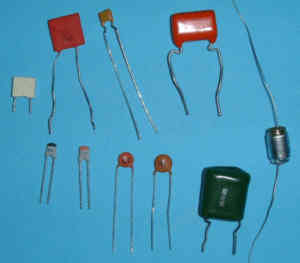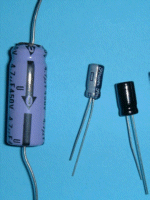 Capacitors
Capacitors Capacitors
Capacitors| Components | Resistors | Capacitors | Inductors | Crystals | Diodes | Transistors |
| FETs | Triacs | Infra-red | ICs | LEDs | Speakers and microphones | Sensors |
|
Values stocked are:
|
 |
||
|
2.2pF
|
4.7pF
|
||
|
10pF
|
22pF
|
47pF
|
|
|
100pF
|
220pF
|
470pF
|
|
|
1nF
|
2.2nF
|
4.7nF
|
|
|
10nF
|
22nF
|
47nF
|
|
|
100nF
|
220nF
|
470nF
|
|
Disc ceramic capacitors are marked with a three digit code. The first
two digits give the two digits of the value and the third digit tells you
the number of 0s, the value is always in pF.
Example 223 is 22000pF which is the same as 22nF.
There is a capacitor code calculator to convert the codes for you.
Alternatively, try your your own skill with an instant test on reading capacitors or try Nick Reeder's capacitor game (check out Nick Reeder's pages at Sinclair College)
But be careful sometimes a 100pF capacitor is marked 101 and sometimes 100 so you may have to check it with a meter!Some of the small ceramic capacitors are marked with the value in digits
and letters p for pico or n for nano. The letter is in the place of the
decimal point.
Examples: 2p2 is 2.2pF, 47n is 47nF, n22 is 0.22nF=220pF
Capacitors of 1mF and larger are all electrolytic. It is very important that you connect these the right way round otherwise they can explode! The negative end usually has - sign next to it or an arrow pointing to the - lead.
 |
1mF
|
2.2mF
|
4.7mF
|
10mF
|
22mF
|
47mF
|
|
100mF
|
220mF
|
470mF
|
1000mF
|